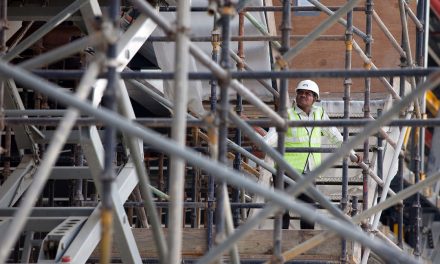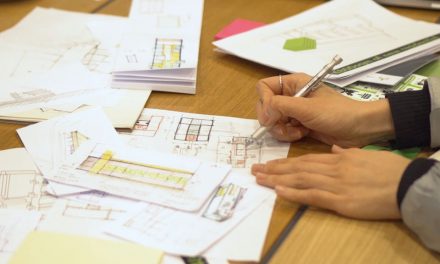The third quarter showed positive momentum for the design industry. September’s ASID Interior Design Billings Index (IDBI) value slipped to a score 54.0 from June’s score of 55.9 but remains in expansionary territory. The September index is stronger than its three-month moving average of 52.5, indicating positive momentum and favorable business conditions. Scores above 50 indicate expansion, while scores below 50 indicate industry contraction. The last IDBI score below 50 was recorded in December 2015. The new project inquiry rate increased to a score of 59.2, slightly above its June score of 58.2.
Figure 1: ASID Interior Design Billings and Inquiries Index, September 2015 to September 2016
Design firms of all sizes enjoyed a positive billings upturn in the third quarter.
*Figure 3: Billings by Size of Firm, September 2015 to September 2016
*The number of respondents is low in the larger firm size categories and results should be interpreted with caution. Figure 3 shows the volatility of the series.
Interior design firms in the South lead billings growth, while firms in the Midwest and Northeast rebound. Interior design firms in the South, Midwest, and Northeast ended the third quarter on good footing. Firms in the South registered a third quarter score of 60, continuing a pattern of positive growth. Midwest firms rebounded nearly 12 points during the quarter to a score of 56, while Northeast firms advanced approximately 8 points during the same three-month period. Design firms in the West reported declining billings (IDBI scores under 50) in the third quarter of 2016 as the IDBI score dropped 14 points (Figure 4).
Figure 4: Billings Index by Region-ASID, September 2015 to September 2016
Design firms specializing in single-family and multifamily residential sectors have lost some momentum from their high IDBI scores in February and March. As shown in Figure 6, billings for design firms specializing in single-family and multifamily residential sectors retreated from earlier in the year, posting scores of 55 and 50 in September.
**Figure 6: Residential Sector Billings, September 2015 to September 2016
Commercial sector interior design firms have rebounded from the disappointing business conditions of the winter months and now report three-month moving average IDBIs of 54 (Commercial) and 53 (Institutional). The design industry mirrors the broader housing and residential construction sectors which showed a softness during the summer months.
**Figure 7: Commercial and Institutional Sector Billings, September 2015 to September 2016
**Figures 6 and 7 illustrate the recent trends in billing performance by market sector. The data is not adjusted for seasonality.
The design industry continues to expect favorable future outcomes. The six-month business conditions index score of 59 for September edged higher than the score of 57 reported for June. The consistency of these scores (above 50) over twelve months supports continued expansion for the design industry.
Figure 8: Six-Month Outlook Comparison ASID, Conference Board, and Dodge Momentum, September 2015 to September 2016
The labor market continues to improve at a slightly slower pace. U.S. payroll employment rose by 156,000 in September. The employment expansion is now in its seventh year and consequently, job gains have moderated compared with the last two years. The unemployment rate edged higher to five percent as more workers stepped into the labor force. Architectural services job growth tapered in the first seven months of the year compared to the same period a year ago. Interior design job growth in 2016 shows four of the eight months with year over year decreases in individual employment.
Construction spending softened mid-year. Total construction spending pulled back in the summer months. The slump in spending momentum was evident in residential, nonresidential, and public spending.
According to Jack Kleinhenz, ASID economist “The U.S. economy, with its 2.9 percent increase in economic activity during the third quarter, appears to have pulled out of the weak cycle of growth that began in late 2015 and continued through the second quarter of 2016. The economy is expected to build momentum in the consumer and housing sectors. This turnaround is good news and a key factor that supports the positive outlook reported by ASID panelists.”
Download the ASID Interior Design Billings Index (IDBI) 3rd Quarter Report
Beginning in November 2010, The American Society of Interior Designers launched its business performance index. The ASID survey, conducted monthly, is designed to provide a unique perspective on current and future business conditions for the interior design industry nationally and regionally for all sizes of firms. A total of 300 firms are invited to participate in this program. Firms included in this survey primarily offer interior design services. While many are interior design only firms, panelists are reporting from architectural firms, engineering, and other related enterprises. Panelists are asked to report on their current billings relative to the previous months and report on recent business inquires. A business sentiment question is also asked regarding how general business conditions, for the entire economy, will be six months from now. The results of the survey are compiled into diffusion indexes which are helpful indicators of changes in the direction of economic activity. The ASID indexes are centered on a score of 50 (above 50 indicates expansion and below 50 contraction).
About ASID
The American Society of Interior Designers believes that design transforms lives. ASID serves the full range of the interior design profession and practice through the Society’s programs, networks, and advocacy. We thrive on the strength of cross-functional and interdisciplinary relationships among designers of all specialties, including workplace, healthcare, retail and hospitality, education, institutional, and residential. We lead interior designers in shared conversations around topics that matter: from evidence-based and human centric design to social responsibility, well-being, and sustainability. We showcase the impact of design on the human experience and the value interior designers provide.
ASID was founded over 40 years ago when two organizations became one, but its legacy dates back to the early 1930s. As we celebrate nearly 85 years of industry leadership, we are leading the future of interior design, continuing to integrate the advantages of local connections with national reach, of small firms with big, and of the places we live with the places we work, play, and heal. Learn more at asid.org.










